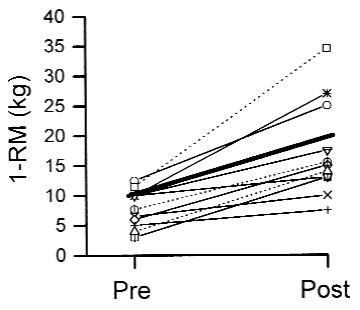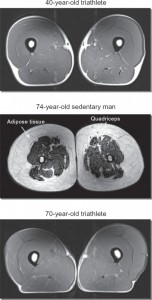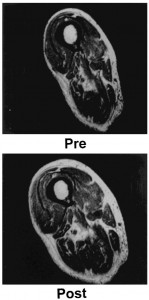It has to do with the duration of time spent being sedentary.
They say a picture is worth a thousand words, but luckily enough today you get both.
Sarcopenia: “poverty of flesh,” or the age-induced loss of skeletal muscle mass, strength, and function = reduced quality of life. Sorry old-timers, but I hereby officially revise the definition from “aging-induced” to “sedentary-induced.” Herein, I present evidence that sarcopenia is not a phenomenon of aging per se, but rather of disuse atrophy. Dear Webster’s & Britannica, please revise accordingly.
Skeletal muscles: use ‘em or lose ‘em #TPMC
Thanks to Julianne Taylor & Skyler Tanner for directing me to these images.
divide and conquer
Exhibit A. Chronic exercise preserves lean muscle mass in masters athletes (Wroblewski et al., 2011)
This study evaluated “high-level recreational athletes.” “Masters” just means they were over 40. And “high-level” doesn’t mean “elite,” it just means they exercised 4-5 times per week. These weren’t super-obsessed gym rats… it’s probably who I’ll be in 7 years [sigh].
They took a lot of measurements which showed these people were pretty fit, but the money shot was this pic:
It wasn’t a randomized double-blind placebo-controlled intervention trial, but that pic made up for all of that. Even if they cherry-picked the scans, I find them compelling. Call it confirmation bias if you like.
Exhibit B. Knee extensor strength, activation, and size in VERY elderly people following strength training (Harridge et al., 1999)
12 weeks of leg exercises performed in 11 adults 85-97 years of age. They were recruited from a geriatric hospital, and despite still kicking well beyond their expiration date, they maintained the ability to get strong:
Some of these gains were likely attributable to the novice effect, or the neuromuscular adaptations that occur in untrained individuals during the onset of a new training program, but nonetheless, these data show there are no intrinsic defects caused by being old that hinder the ability to improve muscle strength [and function].
There was no non-exercising control group with which to compare the following figure, but I assure you, non-exercising 90-year old geriatrics aren’t putting on muscle like this guy did:
I’m not recommending retirees to train for a 480-pound deadlift. Progress can probably be made carrying a gallon of water around the yard, or up and down a flight of stairs; don’t use handicap parking if your only handicap is being old. Sarcopenia is a major reducer of quality of life. You don’t have to join a gym but you have to get off your ass!


